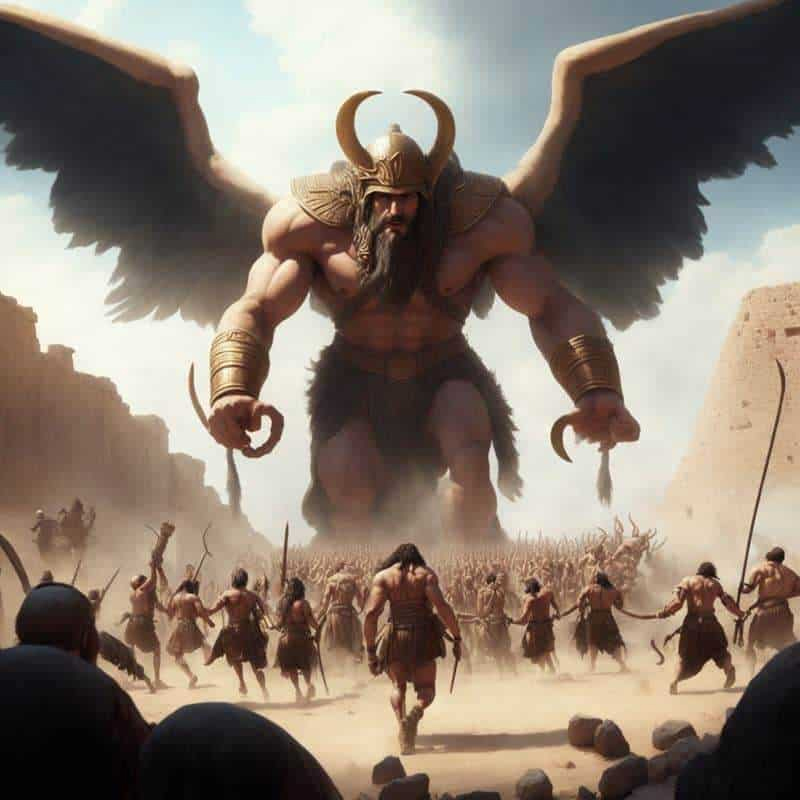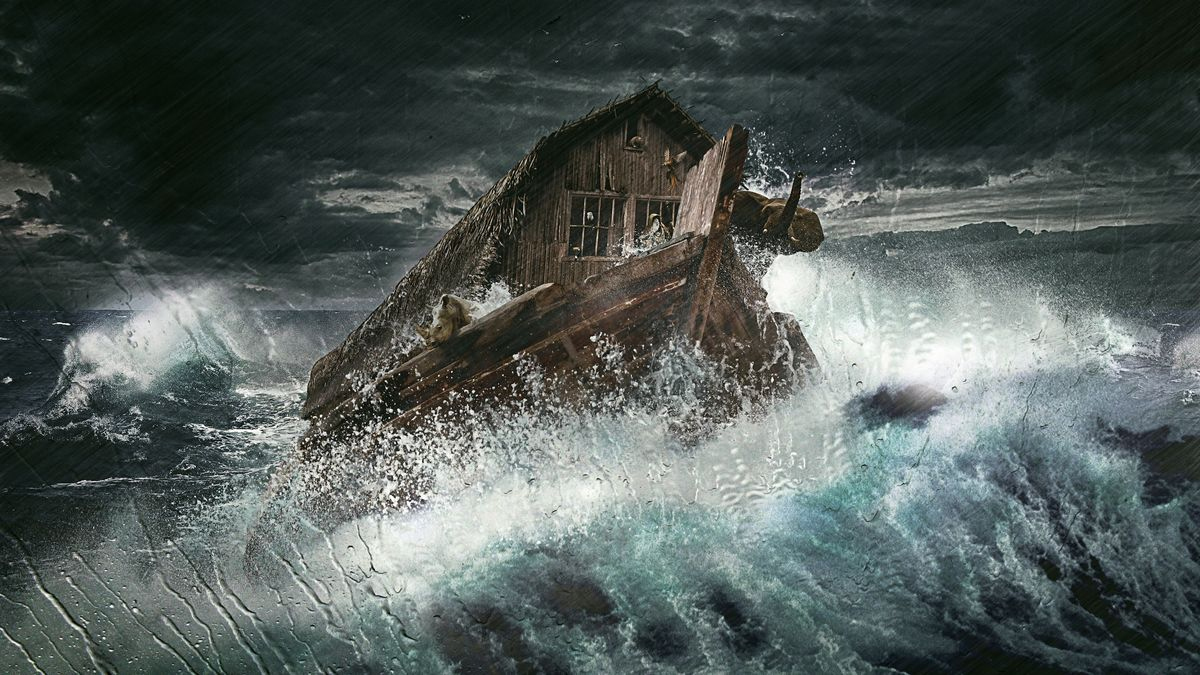The origin of man is an interesting subject of discussion. Delving into the profound imagery of pre-flood times and exploring the specific circumstances leading to the flood, as described in Genesis 6:1-4, we are left with little interpretation. According to the Bible, God chose to purify His creation through the flood, and we are descendants of Noah, who was selected to perpetuate humanity following this event. But what about all those eyebrow raising explanations in Genesis 6:1-4 without back stories? Follow me as we unravel some of these mysteries together and uncover possible supplemental evidence.
“When human beings began to increase in number on the earth and daughters were born to them, the sons of God saw that the daughters of humans were beautiful, and they married any of them they chose. Then the Lord said, ‘My Spirit will not contend with humans forever, for they are mortal; their days will be a hundred and twenty years. The Nephilim were on the earth in those days—and also afterward—when the sons of God went to the daughters of humans and had children by them. They were the heroes of old, men of renown.” Genesis 6:1-4 (NIV)
Within these four verses we’re given profound information that is captivating with no context. Let’s examine some of the essential reasoning from these verses for the flood. God’s insight into wickedness is presented symbolically and enigmatically, unfolding in Genesis 6:1-4, leaving the following unanswered questions:
- Who are the sons of God?
- Who is the Nephilim, known as “heroes of old, men of renown”?
- What is meant by “the Nephilim were on the earth in those days—and also afterward”?
During this era, among the scarce Hebrew manuscripts available, one that surfaced later with the Dead Sea Scrolls is the book of Enoch. Though absent from contemporary Protestant or Catholic editions of the Bible, it offers insight into the “Sons of God” and the “Heroes of old, men of renown” mentioned in Genesis 6:1-4.
A man named Enoch

There was once a man who walked with God before the time of the Flood. His name was Enoch. Enoch is mentioned briefly in Genesis 5 as one of three men that God took from the Earth without physical death into Heaven. Enoch was the first.
Genesis 5:18 (NIV): “When Jared had lived 162 years, he became the father of Enoch.“
Genesis 5:21-24 (NIV): “When Enoch had lived 65 years, he became the father of Methuselah. After he became the father of Methuselah, Enoch walked faithfully with God 300 years and had other sons and daughters. Altogether, Enoch lived a total of 365 years. Enoch walked faithfully with God; then he was no more, because God took him away.”
Enoch was the great-grandfather of Noah. Enoch was the father of Methuselah, who was the father of Lamech, who was the father of Noah. So, while Enoch and Noah are not directly related in a parent-child relationship, they are connected through their familial lineage. This lineage was honored by God, a lineage that would represent His pure creation. This is marked as the origin of man.
What is the Book of Enoch?
The Book of Enoch is an ancient Jewish religious work ascribed to Enoch, the great-grandfather of Noah. It is not included in the canonical Bible used by most modern Christian denominations, but it is considered canonical by the Ethiopian Orthodox Church and Eritrean Orthodox Church.
The Book of Enoch was found in various fragments and manuscripts among the Dead Sea Scrolls, which were discovered in the mid-20th century in the Qumran Caves near the Dead Sea in Israel. The most complete version of the Book of Enoch is known as 1 Enoch, and it was found in several copies among the Dead Sea Scrolls. These discoveries shed light on the ancient Jewish literature and provided scholars with additional insights into the religious beliefs and practices of the time.
The Book of Enoch was never officially included in the Protestant canon of scripture. The Protestant canon, like other Christian canons, was established based on criteria such as apostolic authorship, acceptance by early Christian communities, and doctrinal consistency.
The Book of Enoch was not considered to meet these criteria by the majority of early Christian communities, and it was excluded from the canonization process. Additionally, some of the teachings and themes found in the Book of Enoch were not in line with mainstream Christian beliefs. One of those variations can be found here:
The Bible explains reasoning behind the flood in Genesis 6:5-7 (NIV):
“The Lord saw how great the wickedness of the human race had become on the earth, and that every inclination of the thoughts of the human heart was only evil all the time. The Lord regretted that he had made human beings on the earth, and his heart was deeply troubled. So, the Lord said, ‘I will wipe from the face of the earth the human race I have created—and with them the animals, the birds and the creatures that move along the ground—for I regret that I have made them.'”
The Book of Enoch, known as the Book of the Watchers, explains the reasoning behind the flood (1 Enoch 6-36):
The flood is brought upon the earth as a result of the corruption and sinfulness caused by the fallen angels, also known as the Watchers. These angels descended to earth, lusted after human women, and taught humanity various forms of forbidden knowledge and practices.
The flood is seen as a means of cleansing the earth from this corruption and restoring righteousness. It’s a judgment against both the fallen angels and humanity for their disobedience and wickedness. Additionally, the flood serves to punish the fallen angels, particularly their leader Azazel, who is held responsible for teaching humanity sinful ways.
In summary, according to the Book of Enoch, God floods the earth to cleanse it from the corruption brought about by the fallen angels and to punish both the angels and humanity for their sins. This differs from Genesis, where man’s sinful nature is the reason for the flood.
What can we learn from the Book of Enoch?
The Book of Enoch is divided into several sections, with the most well-known portion being the Book of the Watchers, which describes fallen angels, their interactions with humans, and the resulting corruption on earth. It is an important text for understanding certain apocalyptic and mystical themes in ancient Jewish and Christian literature. The book can be found here: The Complete Book of Enoch (SEV)
The Sons of God

In Genesis 6, we read the sons of God noticed the beauty of these daughters and took any they desired as wives. The sons of God intermingled with human daughters, giving birth to children who became legendary figures, renowned for their prowess and strength. The sons are not ordinary men. We know this because the tampering with man’s lineage resulted in “men of renown”, a hybrid type of being.
In the context of Genesis 6:4, the “men of renown” are understood to be the offspring of the union between the “sons of God” and human women. These offspring are often referred to as the Nephilim, who were described as mighty warriors or heroes of old, renowned for their strength and prowess. The term “men of renown” suggests that these Nephilim were well-known and celebrated figures in ancient times due to their extraordinary abilities and possibly their half angelic status.
This illustrates how angels were lured by the beauty of the daughters of man sacrificing their relationship with God. We can portray Adam’s mistaken choice to disobey God after Eve had eaten from the forbidden fruit. Adam was persuaded to join in disobedience, likely driven by his love for Eve, similar to the angels who succumbed to desire and mingled with the daughters of man.
In the Book of Giants (1 Book of Enoch), it describes how the fallen angels descended to Earth and began to corrupt both humans and animals. They are said to have taught man various forms of forbidden knowledge and magic, leading to widespread corruption and chaos. Among the acts attributed to them is the mixing of species, resulting in the creation of monstrous creatures.
Do you think it’s possible that dinosaurs were created by fallen angels? We find mass burial sites around the world where dinosaurs died instantly. Creationists believe this extinction event lines up with the timeline of the flood.
The Nephilim

The Bible mentions the Nephilim in Genesis 6:1-4 (NIV):
“When human beings began to increase in number on the earth and daughters were born to them, the sons of God saw that the daughters of humans were beautiful, and they married any of them they chose. Then the Lord said, ‘My Spirit will not contend with humans forever, for they are mortal; their days will be a hundred and twenty years.’
The Nephilim were on the earth in those days—and also afterward—when the sons of God went to the daughters of humans and had children by them. They were the heroes of old, men of renown.”
This passage describes the Nephilim as the offspring of unions between the “sons of God” and human women. The Nephilim are described as mighty warriors or heroes of old, renowned for their strength and prowess. The term “Nephilim” itself is often translated as “giants” or “fallen ones.” The passage indicates that these beings were present on the earth before the Flood and even afterward. This would suggest that a fallen creature survived the flood. We can find evidence of the Nephilim survival in the story of the spies going into Canaan and encountering the descendants of the Nephilim. Found in Numbers 13:26-33 (NIV):
“They came back to Moses and Aaron and the whole Israelite community at Kadesh in the Desert of Paran. There they reported to them and to the whole assembly and showed them the fruit of the land. They gave Moses this account: ‘We went into the land to which you sent us, and it does flow with milk and honey! Here is its fruit. But the people who live there are powerful, and the cities are fortified and very large. We even saw descendants of Anak there. The Amalekites live in the Negev; the Hittites, Jebusites and Amorites live in the hill country; and the Canaanites live near the sea and along the Jordan.’
Then Caleb silenced the people before Moses and said, ‘We should go up and take possession of the land, for we can certainly do it.’
But the men who had gone up with him said, ‘We can’t attack those people; they are stronger than we are.’ And they spread among the Israelites a bad report about the land they had explored. They said, ‘The land we explored devours those living in it. All the people we saw there are of great size. We saw the Nephilim there (the descendants of Anak come from the Nephilim). We seemed like grasshoppers in our own eyes, and we looked the same to them.'”
In Numbers 13:33, the Nephilim are described as creatures that in comparison to the Israelites, the Israelites were the size of a grasshopper.
One of the largest grasshoppers in the world today is the Giant Weta which expands to about 2.75” in height. If the average height of the Israelites was 6’, that equates to 72”. That’s a size ratio of 1:26. So, we could speculate that the Nephilim were approximately 156’ tall. This could be an argument for their survival of the flood.
It’s beyond our understanding how a colossal creature could endure the flood, destined for extinction. The Book of Giants Chapter 12 in the Book of Enoch reads:
“Noah goes into the Ark, and the flood comes, and begins to kill all life, but not all the Giants are killed by the flood. In order to fix this, Yehuwah sends the Leviathan, and the Leviathan begins to kill all the Giants and their sons who survived. Ohyah alone survives the attacks of the Leviathan, and kills the Leviathan. The archangel Raphael is sent by Yehuweh in order to punish Ohyah for killing the Leviathan, and to finally restore the earth to purity Ohyah is killed and bound in the dark prison of punishment with the fallen Watchers. The flood being over, and the Giants and their sons still remaining on the earth without bodies, become evil spirits, and are given a law by an angel of Yehuweh how they are to live if they want to avoid being sent to the dark prison of punishment that the Watchers were sent to. And this explains how the Nephilim came to be on the earth after the flood.”
Chapter 12 of the Book of Giants provides further elaboration on the narrative presented in earlier chapters. It describes the dreams and visions of Enoch, who receives revelations about the fallen angels, their offspring, and the impending flood. It connects the narrative of the Nephilim and their corruption of humanity to the flood, which serves as a divine judgment.
In Conclusion
Genesis 6:1-4 provides several key lessons and insights:
1. The Impact of Human Choices: The passage illustrates the consequences of human choices and actions. It describes how the descendants of Adam and Eve began to multiply on the earth, leading to increased corruption and wickedness.
2. The Importance of Obedience: The disobedience of the “sons of God” in taking human wives and producing offspring resulted in divine judgment. It underscores the importance of obedience to God’s commands and the consequences of disobedience.
3. The Power of Influence: The passage highlights the influence that individuals or groups can have on others. The actions of the “sons of God” had a significant impact on the course of human history, leading to the proliferation of evil and corruption.
4. The Complexity of Spiritual Beings: The identity of the “sons of God” is unknown. It raises questions about the nature of these beings and their relationship to humanity.
5. God’s Judgment and Mercy: The passage foreshadows God’s judgment upon the earth through the Flood, while also demonstrating His mercy in preserving Noah and his family. It underscores the balance between divine justice and compassion in dealing with human sin.
6. Citations to Apocryphal Jewish Text: References to giants, “men of renown” and their eventual demise. This profound imagery is the reasoning for God’s divine judgment. The flood event in the Book of Genesis parallels other ancient Hebrew manuscripts, specifically, the Book of Enoch.
Overall, Genesis 6:1-4 serves as a reminder of the complexity of human nature, the consequences of sin, and the need for obedience and faithfulness to God. It invites reflection on the enduring themes of morality, accountability, and divine intervention in the progression of human history.

hello world
Great Article! How can I reach you by phone?